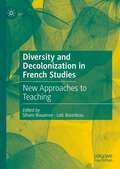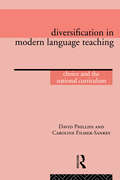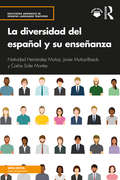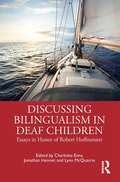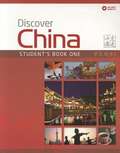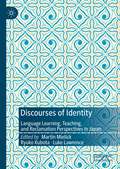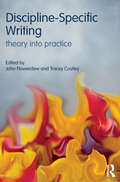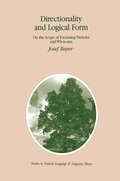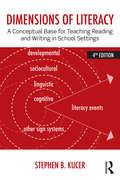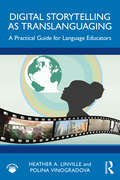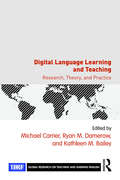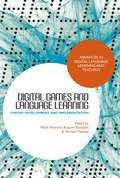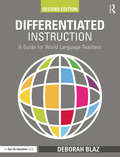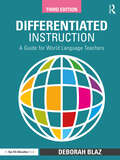- Table View
- List View
Diversity and Decolonization in French Studies: New Approaches to Teaching
by Siham Bouamer Loïc BourdeauThis edited volume presents new and original approaches to teaching the French foreign-language curriculum, reconceptualizing the French classroom through a more inclusive lens. The volume engages with a broad range of scholars to facilitate an understanding of the process of French (de)colonization as well as its reverberations into the postcolonial era, and a deeper engagement with the global interconnectedness of these processes. Chapters in Part I revist the concept of the "francophonie," decenter the field from “metropolitan” or “hexagonal” and white France and underline how current teaching materials reproduce epistemic and colonial violence. Part II adopts an intersectional approach to address topics of gender inclusivity, trans-affirming teaching, queer materials, and ableism. Finally, Part III presents new ways to transform the discipline by affirming our commitment to social justice and making sure that our classrooms are representative of our students’ enriching diversity.
Diversification in Modern Language Teaching: Choice and the National Curriculum
by Caroline Filmer-Sankey David PhillipsAs the effects of European integration become more widely felt the effective teaching of modern languages is moving towards the centre of the educational agenda and more and more schools are considering starting pupils on a first foreign language other than French - a development encouraged by the National Curriculum orders in Modern Languages. Diversification in Modern Language Teaching gives language teachers and heads of department the evidence upon which to decide if diversification is right for them. It looks at the factors which effect children's learning in this area and at the managerial issues both within and outside the school. Throughout it argues that the decision must be a purely educational one, based on pupil motivation and accessibility as well as on particular local strengths among staff and parents.
Diversification in Modern Language Teaching: Choice and the National Curriculum
by Caroline Filmer-Sankey David PhillipsAs the effects of European integration become more widely felt the effective teaching of modern languages is moving towards the centre of the educational agenda and more and more schools are considering starting pupils on a first foreign language other than French - a development encouraged by the National Curriculum orders in Modern Languages. Diversification in Modern Language Teaching gives language teachers and heads of department the evidence upon which to decide if diversification is right for them. It looks at the factors which effect children's learning in this area and at the managerial issues both within and outside the school. Throughout it argues that the decision must be a purely educational one, based on pupil motivation and accessibility as well as on particular local strengths among staff and parents.
La diversidad del español y su enseñanza (Routledge Advances in Spanish Language Teaching)
by Natividad Hernández Muñoz Javier Muñoz-Basols Carlos Soler MontesLa diversidad del español y su enseñanza es la primera publicación concebida para reflexionar sobre la diversidad de la lengua desde un punto de vista crítico, interdisciplinario, institucional, aplicado e internacional. El análisis de doce lecturas y de una detallada guía de explotación didáctica potencian la adquisición de conocimientos sobre la lengua y desvelan la complejidad de la investigación sobre las variedades del español. Características principales: • Artículos de investigación desde diferentes enfoques y perspectivas; • Actividades de reflexión para verificar la asimilación de contenidos; • Análisis crítico de extractos y citas de autoridad (español e inglés); • Preguntas analíticas sobre el estado de la cuestión y recursos institucionales; • Modelos metodológicos de investigación empírica sobre la diversidad de la lengua; • Propuestas de temas para la investigación y el debate dentro y fuera del aula; • Pautas bibliográficas detalladas para profundizar sobre la materia; • Selección de conceptos clave para potenciar la adquisición de terminología lingüística; • Glosario bilingüe en línea (español e inglés) sobre variedades del español, sociolingüística aplicada y política lingüística; • Soluciones de las guías de lectura e información complementaria. Diseñado como libro de texto o material de autoaprendizaje, La diversidad del español y su enseñanza es una herramienta imprescindible para familiarizarse con la diversidad de la lengua. La información será de interés y aplicable en contextos académicos y profesionales de enseñanza, diseño curricular y elaboración de materiales didácticos de español como lengua extranjera o segunda y de herencia. Cualquier investigador, profesor, estudiante o lector podrá acceder de manera crítica y pautada a esta importante parcela de conocimiento sobre el idioma. La diversidad del español y su enseñanza brings together twelve articles that investigate Spanish linguistic variation and the impact this has on Spanish language teaching. Based on a special edition of the Journal of Spanish Language Teaching, each chapter here presents an article from the Journal with an additional reading guide designed to transform the information into a pedagogical tool that can be used and applied in the classroom. Each article is accompanied by critical analysis, reflection activities, questions for future research and debate, and suggestions for further reading. A bilingual glossary covering key terms within Spanish language variation, applied sociolinguistics and language policy is available online at www.routledge.com/9780367651695. This book is a practical overview of the evolution and current state of the study of Spanish language variation and will be of most interest to researchers and teachers of Spanish as a second language who will gain insight into how to include linguistic variation in their teaching.
La diversidad del español y su enseñanza (Routledge Advances in Spanish Language Teaching)
by Natividad Hernández Muñoz Javier Muñoz-Basols Carlos Soler MontesLa diversidad del español y su enseñanza es la primera publicación concebida para reflexionar sobre la diversidad de la lengua desde un punto de vista crítico, interdisciplinario, institucional, aplicado e internacional. El análisis de doce lecturas y de una detallada guía de explotación didáctica potencian la adquisición de conocimientos sobre la lengua y desvelan la complejidad de la investigación sobre las variedades del español. Características principales: • Artículos de investigación desde diferentes enfoques y perspectivas; • Actividades de reflexión para verificar la asimilación de contenidos; • Análisis crítico de extractos y citas de autoridad (español e inglés); • Preguntas analíticas sobre el estado de la cuestión y recursos institucionales; • Modelos metodológicos de investigación empírica sobre la diversidad de la lengua; • Propuestas de temas para la investigación y el debate dentro y fuera del aula; • Pautas bibliográficas detalladas para profundizar sobre la materia; • Selección de conceptos clave para potenciar la adquisición de terminología lingüística; • Glosario bilingüe en línea (español e inglés) sobre variedades del español, sociolingüística aplicada y política lingüística; • Soluciones de las guías de lectura e información complementaria. Diseñado como libro de texto o material de autoaprendizaje, La diversidad del español y su enseñanza es una herramienta imprescindible para familiarizarse con la diversidad de la lengua. La información será de interés y aplicable en contextos académicos y profesionales de enseñanza, diseño curricular y elaboración de materiales didácticos de español como lengua extranjera o segunda y de herencia. Cualquier investigador, profesor, estudiante o lector podrá acceder de manera crítica y pautada a esta importante parcela de conocimiento sobre el idioma. La diversidad del español y su enseñanza brings together twelve articles that investigate Spanish linguistic variation and the impact this has on Spanish language teaching. Based on a special edition of the Journal of Spanish Language Teaching, each chapter here presents an article from the Journal with an additional reading guide designed to transform the information into a pedagogical tool that can be used and applied in the classroom. Each article is accompanied by critical analysis, reflection activities, questions for future research and debate, and suggestions for further reading. A bilingual glossary covering key terms within Spanish language variation, applied sociolinguistics and language policy is available online at www.routledge.com/9780367651695. This book is a practical overview of the evolution and current state of the study of Spanish language variation and will be of most interest to researchers and teachers of Spanish as a second language who will gain insight into how to include linguistic variation in their teaching.
Discussing Bilingualism in Deaf Children: Essays in Honor of Robert Hoffmeister
by Charlotte EnnsThis collection unites expert scholars in a comprehensive survey of critical topics in bilingual deaf education. Drawing on the work of Dr. Robert Hoffmeister, chapters explore the concept that a strong first language is critical to later learning and literacy development. In thought-provoking essays, authors discuss the theoretical underpinnings of bilingual deaf education, teaching strategies for deaf students, and the unique challenges of signed language assessment. Essential for anyone looking to expand their understanding of bilingualism and deafness, this volume reflects Dr. Hoffmeister’s impact on the field while demonstrating the ultimate resilience of human language and literacy systems.
Discussing Bilingualism in Deaf Children: Essays in Honor of Robert Hoffmeister
by Charlotte Enns Jonathan Henner Lynn McQuarrieThis collection unites expert scholars in a comprehensive survey of critical topics in bilingual deaf education. Drawing on the work of Dr. Robert Hoffmeister, chapters explore the concept that a strong first language is critical to later learning and literacy development. In thought-provoking essays, authors discuss the theoretical underpinnings of bilingual deaf education, teaching strategies for deaf students, and the unique challenges of signed language assessment. Essential for anyone looking to expand their understanding of bilingualism and deafness, this volume reflects Dr. Hoffmeister’s impact on the field while demonstrating the ultimate resilience of human language and literacy systems.
Discover China Student Book One (PDF)
by Anqi DingSpecially designed for young adult and adult learners, this four-level beginner Mandarin Chinese course employs a communicative approach to language learning. Emphasis is placed on pair work, group work and on a variety of speaking and listening activities to help students become confident Chinese language speakers.
Discourses of Identity: Language Learning, Teaching, and Reclamation Perspectives in Japan
by Martin Mielick Ryuko Kubota Luke LawrenceThis edited book draws on research on identity in language education to present a detailed and multi-faceted study of identity in language learning, teaching and revitalization settings in the context of Japan. It employs a diverse range of theoretical approaches, including poststructuralism, critical realism, cognitive behavioral theory, and complexity theory,, as well as methodologies such as linguistic ethnography, narrative enquiry, and critical multimodal discourse analysis. The authors focus on multiple dimensions of identity, illuminating linguistic, cultural and human complexity as manifested in language teaching and learning. This book will be of interest to advanced students and scholars of TESOL, applied linguistics, education, Japanese studies, East Asian studies, linguistic anthropology, indigenous languages and sociolinguistics.
Discipline-Specific Writing: Theory into practice
by John Flowerdew Tracey CostleyDiscipline-Specific Writing provides an introduction and guide to the teaching of this topic for students and trainee teachers. This book highlights the importance of discipline-specific writing as a critical area of competence for students, and covers both the theory and practice of teaching this crucial topic. With chapters from practitioners and researchers working across a wide range of contexts around the world, Discipline-Specific Writing: Explores teaching strategies in a variety of specific areas including science and technology, social science and business; Discusses curriculum development, course design and assessment, providing a framework for the reader; Analyses the teaching of language features including grammar and vocabulary for academic writing; Demonstrates the use of genre analysis, annotated bibliographies and corpora as tools for teaching; Provides practical suggestions for use in the classroom, questions for discussion and additional activities with each chapter. Discipline-Specific Writing is key reading for students taking courses in English for Specific Purposes, Applied Linguistics, TESOL, TEFL and CELTA.
Discipline-Specific Writing: Theory into practice
by John Flowerdew Tracey CostleyDiscipline-Specific Writing provides an introduction and guide to the teaching of this topic for students and trainee teachers. This book highlights the importance of discipline-specific writing as a critical area of competence for students, and covers both the theory and practice of teaching this crucial topic. With chapters from practitioners and researchers working across a wide range of contexts around the world, Discipline-Specific Writing: Explores teaching strategies in a variety of specific areas including science and technology, social science and business; Discusses curriculum development, course design and assessment, providing a framework for the reader; Analyses the teaching of language features including grammar and vocabulary for academic writing; Demonstrates the use of genre analysis, annotated bibliographies and corpora as tools for teaching; Provides practical suggestions for use in the classroom, questions for discussion and additional activities with each chapter. Discipline-Specific Writing is key reading for students taking courses in English for Specific Purposes, Applied Linguistics, TESOL, TEFL and CELTA.
Directionality and Logical Form: On the Scope of Focusing Particles and Wh-in-situ (Studies in Natural Language and Linguistic Theory #34)
by Josef BayerDirectionality and Logical Form provides a detailed treatment of the syntax of focusing particles, such as only and even in a cross-linguistic perspective. The derivation of logical forms is shown to be under the control, not only of the ECP and subjacency, but also of directionality of government and the particular word-order parameter that holds in a given language: head-final languages systematically disallow certain derivations or readings that are available in head-initial languages. The reason is that heads that deviate in their selection properties from canonical head-finality project a directionality barrier. Various strategies are explored by which this barrier can be circumvented. Although the theory is developed mainly on the basis of the head position in German, it can be directly used to explain constraints on the scope of Wh-in-situ in Bengali and closely related languages. Audience: Syntacticians and semanticists interested in parametric variation, as well as linguists working on Germanic and/or Indo-Aryan languages.
Dimensions of Literacy: A Conceptual Base for Teaching Reading and Writing in School Settings
by Stephen B. KucerThis popular text, now in its fourth edition, “unpacks” the various dimensions of literacy—linguistic and other sign systems; cognitive; sociocultural; and developmental—and at the same time accounts for the interrelationships among them. Distinguished by its examination of literacy from a multidimensional and interdisciplinary perspective, it provides a strong conceptual foundation upon which literacy curriculum and instruction in school settings can be grounded. Linking theory and research to practice in an understandable, user-friendly manner, the text provides in-depth coverage of the dimensions of literacy, includes demonstrations and “hands-on” activities, examines authentic reading and writing events that reflect key concepts, and summarizes the concepts in tables and figures. Changes in the Fourth Edition• Addresses academic language, new literacies/multiliteracies, and their relationship to literacy learning• More fully develops the developmental dimension of literacy in separate chapters on adult mediation and learner construction• Expands the discussion of multimodal literacies• Extends and integrates the discussion of bilingualism and biliteracy throughout the text• Integrates instructional implications more fully throughout
Dimensions of Literacy: A Conceptual Base for Teaching Reading and Writing in School Settings
by Stephen B. KucerThis popular text, now in its fourth edition, “unpacks” the various dimensions of literacy—linguistic and other sign systems; cognitive; sociocultural; and developmental—and at the same time accounts for the interrelationships among them. Distinguished by its examination of literacy from a multidimensional and interdisciplinary perspective, it provides a strong conceptual foundation upon which literacy curriculum and instruction in school settings can be grounded. Linking theory and research to practice in an understandable, user-friendly manner, the text provides in-depth coverage of the dimensions of literacy, includes demonstrations and “hands-on” activities, examines authentic reading and writing events that reflect key concepts, and summarizes the concepts in tables and figures. Changes in the Fourth Edition• Addresses academic language, new literacies/multiliteracies, and their relationship to literacy learning• More fully develops the developmental dimension of literacy in separate chapters on adult mediation and learner construction• Expands the discussion of multimodal literacies• Extends and integrates the discussion of bilingualism and biliteracy throughout the text• Integrates instructional implications more fully throughout
Digital Storytelling as Translanguaging: A Practical Guide for Language Educators
by Heather A. Linville Polina VinogradovaThis innovative, accessible book is an introduction to using digital storytelling in language teaching, with a focus on English as an Additional Language (EAL) instruction. Linville and Vinogradova provide a clear framework that addresses translanguaging and multimodal meaning making in teaching multilingual learners (MLs) through use of digital storytelling.This book provides detailed guidance on how to incorporate digital storytelling into language teaching, building on recent developments in the fields of TESOL and language education that position multilingualism and multiliteracies as important components of any language instruction. Through this text and accompanying activities, readers will understand how to work with MLs to create multimodal digital texts. This book offers an easy-to-follow, step-by-step process for language educators to follow to support MLs’ digital storytelling projects in any EAL classroom. Featured digital storytelling projects from EAL practitioners in various contexts, as well as multiple examples and resources, are included for each stage of the process, always grounded in contemporary TESOL theories (e.g., critical pedagogy, culturally responsive teaching, translanguaging, and a pedagogy of multiliteracies). This framework supports the development of multilingualism and multiliteracies and can be adapted by educators of other world languages for any language education setting.Grounded in contemporary TESOL theories, this book is an essential text for courses on technology in TESOL and TESOL methods courses, as well as for language educators.
Digital Storytelling as Translanguaging: A Practical Guide for Language Educators
by Heather A. Linville Polina VinogradovaThis innovative, accessible book is an introduction to using digital storytelling in language teaching, with a focus on English as an Additional Language (EAL) instruction. Linville and Vinogradova provide a clear framework that addresses translanguaging and multimodal meaning making in teaching multilingual learners (MLs) through use of digital storytelling.This book provides detailed guidance on how to incorporate digital storytelling into language teaching, building on recent developments in the fields of TESOL and language education that position multilingualism and multiliteracies as important components of any language instruction. Through this text and accompanying activities, readers will understand how to work with MLs to create multimodal digital texts. This book offers an easy-to-follow, step-by-step process for language educators to follow to support MLs’ digital storytelling projects in any EAL classroom. Featured digital storytelling projects from EAL practitioners in various contexts, as well as multiple examples and resources, are included for each stage of the process, always grounded in contemporary TESOL theories (e.g., critical pedagogy, culturally responsive teaching, translanguaging, and a pedagogy of multiliteracies). This framework supports the development of multilingualism and multiliteracies and can be adapted by educators of other world languages for any language education setting.Grounded in contemporary TESOL theories, this book is an essential text for courses on technology in TESOL and TESOL methods courses, as well as for language educators.
Digital Language Learning and Teaching: Research, Theory, and Practice (Global Research on Teaching and Learning English)
by Michael Carrier Ryan M. Damerow Kathleen M. BaileyThis carefully balanced set of studies and practitioner research projects carried out in various learning contexts around the world highlights cutting-edge research in the use of digital learning technologies in language classrooms and in online learning. Providing an overview of recent developments in the application of educational technology to language learning and teaching, it looks at the experience of researchers and practitioners in both formal and informal (self-study) learning contexts, bringing readers up to date with this rapidly changing field and the latest developments in research, theory, and practice at both classroom and education system levels.
Digital Language Learning and Teaching: Research, Theory, and Practice (Global Research on Teaching and Learning English)
by Michael Carrier Ryan M. Damerow Kathleen M. BaileyThis carefully balanced set of studies and practitioner research projects carried out in various learning contexts around the world highlights cutting-edge research in the use of digital learning technologies in language classrooms and in online learning. Providing an overview of recent developments in the application of educational technology to language learning and teaching, it looks at the experience of researchers and practitioners in both formal and informal (self-study) learning contexts, bringing readers up to date with this rapidly changing field and the latest developments in research, theory, and practice at both classroom and education system levels.
Digital Games in Language Learning: Case Studies and Applications (New Directions in Computer Assisted Language Learning)
by Mark PetersonThis edited volume provides a comprehensive overview of contemporary research into the application of digital games in second and foreign language teaching and learning. As the use of digital games in foreign language education continues to expand, there is a need for publications that provide a window into recent innovations in this increasingly influential area of language education. This volume is wide ranging in scope incorporating both theory and practice and includes contributions from authorities in the field. Areas covered include research reviews and a range of case studies conducted in a variety of international contexts. This volume represents an essential guide to developments in this field and will have wide appeal to students, language educators, game and instructional designers.
Digital Games in Language Learning: Case Studies and Applications (New Directions in Computer Assisted Language Learning)
by Mark Peterson Nasser JabbariThis edited volume provides a comprehensive overview of contemporary research into the application of digital games in second and foreign language teaching and learning. As the use of digital games in foreign language education continues to expand, there is a need for publications that provide a window into recent innovations in this increasingly influential area of language education. This volume is wide ranging in scope incorporating both theory and practice and includes contributions from authorities in the field. Areas covered include research reviews and a range of case studies conducted in a variety of international contexts. This volume represents an essential guide to developments in this field and will have wide appeal to students, language educators, game and instructional designers.
Digital Games and Language Learning: Theory, Development and Implementation (Advances in Digital Language Learning and Teaching)
by Mark Peterson, Kasumi Yamazaki and Michael ThomasDue to the rapid development of gaming technologies in recent years, there has been a surge of interest in the role that digital games can play in foreign and second language learning. Bringing together innovative research from an international team of contributors, this book provides a comprehensive overview of the use of digital games in computer-assisted language learning (CALL).The book firstly lays the theoretical foundations and outlines various rationales for using digital games, incorporating contemporary theories of second language acquisition. It also explores the development and impact of digital games designed specifically for language learning, giving due consideration to design principles, pedagogical requirements and student health. Chapters then draw on case studies from Europe and Japan to analyse in-game interaction, attitudes and participation in both institutional and out-of-classroom settings. Seamlessly combining theory with practical application, this book outlines recent developments in the field and the direction of future research, and is a valuable resource for instructors, researchers and practitioners who are designing games or looking to use them in their classrooms.
Digital Games and Language Learning: Theory, Development and Implementation (Advances in Digital Language Learning and Teaching)
Due to the rapid development of gaming technologies in recent years, there has been a surge of interest in the role that digital games can play in foreign and second language learning. Bringing together innovative research from an international team of contributors, this book provides a comprehensive overview of the use of digital games in computer-assisted language learning (CALL).The book firstly lays the theoretical foundations and outlines various rationales for using digital games, incorporating contemporary theories of second language acquisition. It also explores the development and impact of digital games designed specifically for language learning, giving due consideration to design principles, pedagogical requirements and student health. Chapters then draw on case studies from Europe and Japan to analyse in-game interaction, attitudes and participation in both institutional and out-of-classroom settings. Seamlessly combining theory with practical application, this book outlines recent developments in the field and the direction of future research, and is a valuable resource for instructors, researchers and practitioners who are designing games or looking to use them in their classrooms.
Differentiated Instruction: A Guide for World Language Teachers
by Deborah BlazIn this new edition of a bestseller, author Deborah Blaz helps you differentiate lessons for your world language students based on their learning styles, interests, prior knowledge, and comfort zones. This practical book uses brain-based teaching strategies to help students of all ability levels thrive in a rigorous differentiated learning environment. Each chapter provides classroom-tested activities and tiered lesson plans to help you teach vocabulary, speaking, listening, reading, and writing in world language classes in ways that are interactive, engaging, and effective for all learners. Features new to this edition include: Sample thematic units to make your lessons more authentic and immersive New strategies for using technology to differentiate world language instruction Additional checklists, rubrics, and feedback forms to help you organize your lesson plans and track students’ progress New connections to the Common Core State Standards, the ACTFL Standards, Webb’s Depth of Knowledge, and Bloom’s Taxonomy You’ll also learn how to differentiate assessment effectively to help all students show their full potential. Classroom-ready tools and templates can be downloaded as free eResources from our website (www.routledge.com/9781138906181) for immediate use.
Differentiated Instruction: A Guide for World Language Teachers
by Deborah BlazIn this new edition of a bestseller, author Deborah Blaz helps you differentiate lessons for your world language students based on their learning styles, interests, prior knowledge, and comfort zones. This practical book uses brain-based teaching strategies to help students of all ability levels thrive in a rigorous differentiated learning environment. Each chapter provides classroom-tested activities and tiered lesson plans to help you teach vocabulary, speaking, listening, reading, and writing in world language classes in ways that are interactive, engaging, and effective for all learners. Features new to this edition include: Sample thematic units to make your lessons more authentic and immersive New strategies for using technology to differentiate world language instruction Additional checklists, rubrics, and feedback forms to help you organize your lesson plans and track students’ progress New connections to the Common Core State Standards, the ACTFL Standards, Webb’s Depth of Knowledge, and Bloom’s Taxonomy You’ll also learn how to differentiate assessment effectively to help all students show their full potential. Classroom-ready tools and templates can be downloaded as free eResources from our website (www.routledge.com/9781138906181) for immediate use.
Differentiated Instruction: A Guide for World Language Teachers
by Deborah BlazIn the third edition of a bestseller, author Deborah Blaz helps you differentiate lessons for your world language students based on their learning styles, interests, prior knowledge, and comfort zones. This practical book uses brain-based teaching strategies to help students of all ability levels thrive in a rigorous differentiated learning environment. Each chapter provides classroom-tested activities and tiered lesson plans to help you teach vocabulary, speaking, listening, reading, and writing in world language classes in ways that are interactive, engaging, and effective for all learners.Features new to this edition include: activities aligned with the latest ACTFL and CEFR standards ideas and activities for project-based learning, virtual learning, and learning with digital tools, such as ChatGPT up-to-date latest guidance on learning styles and using variety in teaching more photocopiable forms, checklists, and handouts for suggested activities You’ll also learn how to differentiate assessment effectively to help all students show their full potential. Classroom-ready tools and templates can be downloaded as free support material from our website (www.routledge.com/9781032258287) for immediate use.
